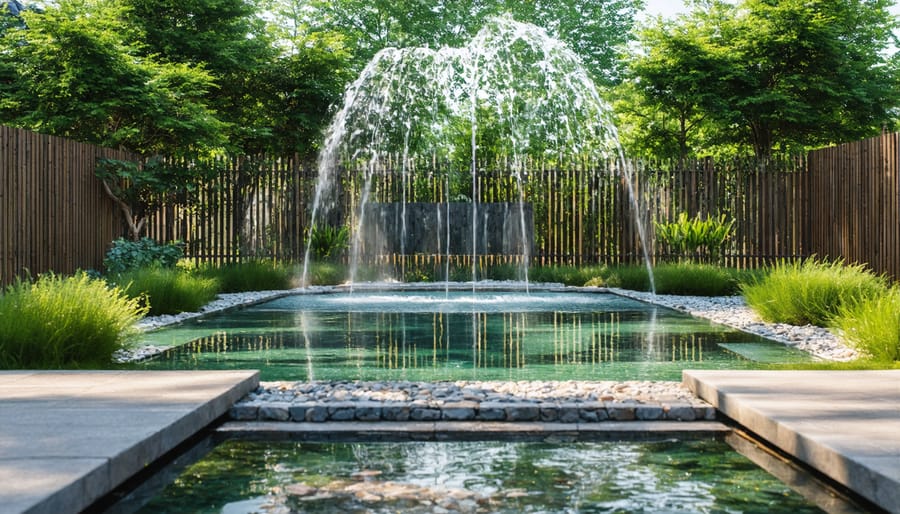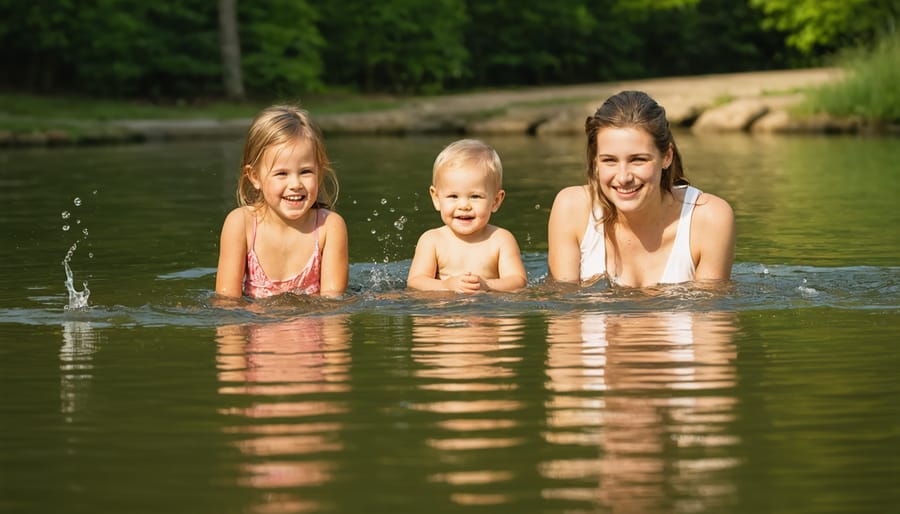
Your Beautiful Pond Could Be Dangerous: Protecting Kids and Pets from Water
Every three days, a child drowns in a non-pool setting—and backyard ponds account for a heartbreaking number of these tragedies. Your beautiful water garden, the one that brings you so much joy with its burbling fountains and darting koi, can become a hazard in seconds. A toddler can drown in just two inches of water, and curious pets face similar risks when they slip on algae-covered edges or become disoriented in murky water.
**Install physical barriers immediately.** Sturdy fencing at least four feet high with self-closing, self-latching gates creates your first line of defense. For smaller ponds, rigid metal grids or pond netting placed just below the water surface can support a child’s weight while remaining nearly invisible. These barriers don’t compromise your pond’s beauty—they simply buy you precious seconds to intervene.
**Design shallow ledges and escape routes into your pond structure.** Gradual slopes rather than steep drop-offs give children and animals a chance to regain footing. Add strategically placed rocks or textured ramps that provide grip for animals trying to climb out. These modifications blend naturally into your landscape while serving as critical safety features.
**Establish non-negotiable supervision rules.** Young children need an adult within arm’s reach near water—not just watching from the deck. Designate a “water watcher” during gatherings who isn’t distracted by phones or conversations. For pets, supervised pond visits should become routine, especially during their initial introductions to your water feature.
Your pond can remain a source of tranquility and beauty while being safe for every family member who explores your backyard.
Why Pond Owners Need to Think About Drowning Prevention
The Reality of Backyard Water Accidents
Every year, hundreds of children under five drown in backyard water features, and these tragedies happen silently—often in less than two minutes. What surprises many pond owners is that danger exists in remarkably shallow water. A child can drown in as little as two inches of water, while pets face risks in depths as shallow as six inches, depending on their size.
Your beautiful backyard pond presents different challenges than a swimming pool. Unlike pools with their visible, uniform depths, ponds have irregular edges, slippery rocks, and aquatic plants that can entangle small limbs or paws. The naturalistic design we love—those gently sloping banks and lush vegetation—can make it harder to spot someone in trouble. Pond water is often less clear than treated pool water, reducing visibility if a child or pet falls in.
I learned this firsthand when my neighbor’s toddler wandered toward my koi pond during a barbecue. Thankfully, we caught him in time, but that heart-stopping moment changed how I approached my water feature forever. Following essential pond safety tips isn’t about creating an eyesore—it’s about ensuring everyone can enjoy your aquatic haven without worry.
Who’s Most at Risk Around Your Pond
Let’s be honest—certain family members need extra watchful eyes around your pond. Toddlers aged 1-4 are the highest risk group, as they’re naturally curious but lack awareness of hidden pond dangers. Young children up to age 10 can also get into trouble, especially if they’re playing unsupervised or testing their boundaries.
Don’t forget about your furry friends! Dogs, particularly excitable puppies and breeds that aren’t natural swimmers, can slip on wet edges or panic in deeper water. Even some adventurous cat breeds might investigate your pond and find themselves in a scary situation.
Visiting children pose another concern—they don’t know your yard’s layout or understand the pond rules your own kids follow. Grandchildren, neighbors’ kids, or party guests can wander toward water features without realizing the risks. That’s why layered safety measures matter so much.
Physical Barriers That Actually Work
Fencing Solutions for Every Budget and Style
Choosing the right fence doesn’t mean sacrificing your pond’s beauty! I’ve tried several options over the years, and there’s truly something for every taste and budget.
**Decorative metal barriers** offer the perfect blend of security and style. Wrought iron or powder-coated aluminum fencing adds elegance while providing a sturdy barrier. Look for designs with vertical bars spaced no more than 4 inches apart to prevent small children from squeezing through. I particularly love how these complement formal pond designs.
**Mesh pool fencing** is your budget-friendly champion. These removable barriers are surprisingly strong, nearly invisible from a distance, and perfect for renters or those wanting flexibility. Installation is straightforward—I set mine up in an afternoon using existing posts.
**Natural plant barriers** create a living fence using dense shrubs like boxwood or holly. While beautiful, remember these take time to establish and should complement, not replace, physical barriers for young children.
**Removable options** work wonderfully when you need temporary protection during parties or when grandchildren visit. Panel systems with secure latches can be stored when not needed.
Whatever style you choose, aim for at least 4 feet in height with self-closing, self-latching gates positioned out of children’s reach.

Pond Netting and Grids: When and How to Use Them
Pond netting offers two distinct safety approaches depending on your needs. **Debris nets** are lightweight covers designed to catch leaves and keep your pond clean—they’re not strong enough for safety purposes. **Heavy-duty safety nets**, on the other hand, feature reinforced materials that can support significant weight, preventing children or pets from breaking through if they step onto the pond surface.
For maximum protection, consider **rigid grid systems**. These sturdy metal or composite grids sit just below the water surface, creating an invisible barrier while still allowing you to see your fish. I’ve installed these on larger ponds where traditional netting felt visually intrusive, and they’re fantastic for maintaining your pond’s natural appearance.
Installation requires securing anchor points around your pond’s perimeter—think every 18-24 inches for optimal tension. The netting should be taut enough that nothing can push through, yet accessible when you need to perform maintenance.
**Pros**: Affordable, relatively easy to install, works for irregular pond shapes.
**Cons**: Can interfere with feeding fish, requires regular checking for debris accumulation, may need seasonal removal for winter.
For small ponds (under 100 square feet), safety netting provides excellent protection. Larger ponds benefit more from rigid grids or combining netting with other barriers for comprehensive coverage.
Edge Barriers and Shallow Shelves
Your pond’s edges are your first line of defense against accidents, and the good news is that safe design can be beautiful too! Start by creating graduated depths—think of it as a gentle staircase rather than a sudden drop-off. Shallow shelves around the perimeter (6-12 inches deep) give children and pets a safer zone while providing perfect spots for marginal plants.
I learned this lesson when my neighbor’s curious puppy took an unexpected dip. Now I always recommend installing pet escape ramps at multiple locations around the pond. These textured, sloped surfaces (you can buy them or DIY with non-slip materials) give animals an easy way out if they fall in.
Natural barriers work wonderfully without looking like fencing. Place larger rocks along vulnerable edges—they’re difficult for toddlers to navigate but complement your landscape perfectly. Dense plantings of ornamental grasses or thorny shrubs create both visual appeal and a gentle deterrent. Position taller plants behind these barriers so kids aren’t tempted to reach through. Remember, you’re creating layers of protection that work together while maintaining that natural pond aesthetic you love.
Smart Design Choices That Prevent Accidents
Location, Location, Location
When planning your pond, think strategically about placement before you dig. I learned this the hard way when I initially sketched my first pond right next to the play structure—thankfully, my neighbor gently pointed out the potential hazard before I broke ground!
Position your pond away from play areas, swings, and sandbox zones where kids naturally gravitate. Instead, place it where you can see it clearly from your main living spaces—kitchen windows and family rooms are ideal vantage points. This way, you’ll naturally keep an eye on things while going about your daily routines.
Here’s another crucial tip: avoid placing ponds directly between your house and popular destinations like sheds, gardens, or the grill area. High-traffic paths create more opportunities for accidental encounters, especially during evening hours when visibility drops. Consider how shadows fall throughout the day and whether trees or structures might block your view at certain times. Good sightlines aren’t just about aesthetics—they’re your first line of defense in pond safety.
Pond Depth and Edge Design for Safety
One of the smartest things I learned from years of pond keeping is that gradual slopes beat steep drops every time. Beach-style entries—where the pond gradually deepens from a shallow ledge—let everyone see exactly where they’re stepping and give anyone who falls in a way to walk right back out. Aim for shelves at 6-12 inches deep before dropping to deeper zones.
For safe water feature design, visible edges matter enormously. Dark liner can hide depth changes, so consider lighter colors or contrasting edging stones that clearly define where water begins. Keep recreational areas under 18 inches if young children visit, and reserve depths beyond 24 inches for fish overwintering zones only.
Retrofitting an existing pond? You can add stacked rocks or cinder blocks (covered with liner) to create shallow shelves. I’ve also seen families successfully reduce depth by raising the entire pond bottom with sand and gravel layers. Yes, it’s work, but it transforms a hazard into something everyone can enjoy safely.
Adding Features That Alert You to Trouble
Technology can be your vigilant partner when you can’t be watching every second. Motion-sensor alarms placed near your pond’s edge will alert you instantly if someone approaches the water. I installed one near my koi pond after a close call with my neighbor’s toddler, and the peace of mind has been invaluable.
Pool alarms, which float on the water’s surface and detect disturbances, work beautifully for larger ponds too. They’re weatherproof and battery-operated, making installation a breeze. For gates and doors leading to your pond area, consider installing latches that create an audible click or beep—this simple sound lets you know when someone’s heading outside.
Wireless driveway alarms adapted for backyard use are another affordable option. Position the sensor beam across pathways to your pond, and the receiver indoors will chime when the beam breaks. These layered alert systems create multiple safety checkpoints, giving you crucial seconds to respond.
Rules and Supervision That Save Lives
Creating Your Family’s Pond Safety Rules
Every family needs clear, age-appropriate rules that everyone can follow. For toddlers and young children, keep it simple: “Never go near the pond without a grown-up.” For older kids, you might expand this to: “Always wear your life jacket near the pond” or “Stay three steps back from the edge unless an adult is with you.”
I’ve found that posting a colorful sign near your pond works wonders—not just for your family, but for visiting friends and neighbors too. Include picture symbols alongside words so even non-readers understand. Make sure to review water garden safety practices with guests before they explore your yard.
Hold a family meeting to establish these rules together. When kids help create the guidelines, they’re more likely to follow them! Consider role-playing scenarios: “What would you do if your ball went in the pond?” The right answer? Get an adult immediately—never reach for it themselves. Post your rules at kid-height and adult-height, and don’t forget to brief babysitters, grandparents, and playdate parents about your specific pond boundaries.
The Reality of Active Supervision
Active supervision isn’t scrolling through your phone while occasionally glancing at the pond—it means eyes-on, every moment. I learned this the hard way during a backyard gathering when I thought I could chat with guests and “keep an eye” on the kids near my koi pond. It only took seconds for my nephew to lean too far over the edge.
True supervision means designating one adult as the “water watcher” during gatherings—someone who commits to watching the pond area exclusively, without distractions. No phones, no conversations, no multitasking. After 15-20 minutes, rotate to a fresh watcher because attention naturally drifts.
Our brains can’t effectively split focus between socializing and safety monitoring. Even experienced parents underestimate how quickly accidents happen. Drowning is silent—there’s no splashing or calling for help like in movies. By the time you notice something’s wrong, precious seconds have been lost. Make active supervision non-negotiable around your water feature.

Teaching Water Respect Without Fear
Teaching children about water safety starts with age-appropriate conversations. For toddlers, simple rules like “always hold an adult’s hand near water” work best. Older kids can understand drowning risks and learn basic self-rescue techniques. Make it a positive experience—practice supervised water play, demonstrate safe behaviors, and praise good choices rather than using scare tactics.
For pets, establish clear boundaries early. Train dogs to enter only with permission, and reward them when they stay away from pond edges. Cats typically avoid water naturally, but keep watch during their curious kitten phase. I’ve found that consistent, gentle redirection builds respect without creating anxiety. Remember, the goal is awareness and caution, not fear that prevents everyone from enjoying your beautiful water feature together.
Pet-Specific Safety Considerations
Why Pets Struggle in Ponds
Even dogs who paddle joyfully at the lake can struggle in backyard ponds. The biggest culprit? Those beautiful, smooth pond edges that look so natural. When wet, they become slick launching pads—easy to slip into, nearly impossible to scramble out of. I learned this the hard way when my neighbor’s Labrador, an excellent swimmer, panicked in my pond because he couldn’t find his exit point.
Unlike pools with visible steps, ponds often have uniform edges that confuse disoriented pets. They’ll swim in circles, desperately searching for solid ground while exhaustion sets in. Small dogs and cats tire especially quickly, and even a few minutes of frantic paddling can deplete their energy. Cold water accelerates this fatigue. Add aquatic plants that might tangle legs or water features creating current, and you’ve got a genuine hazard—regardless of how water-loving your pet normally is.
Escape Routes and Pet Safety Features
Even the best swimmers in the animal kingdom can panic and struggle to escape a pond. I learned this the hard way when my neighbor’s golden retriever fell in and couldn’t find his way out despite being a strong swimmer. That’s when I realized exit strategies aren’t just nice to have—they’re essential.
**Install multiple escape routes** around your pond’s perimeter. Pet ramps with non-slip surfaces work wonderfully and blend naturally into pond landscapes. Position them at opposite ends so there’s always an accessible exit nearby. You can purchase commercial pet ramps or build DIY versions using textured decking materials.
**Create shallow beach-entry zones** with gradually sloping edges. These natural-looking areas give pets (and wildlife) easy footing to climb out. I added a pebble beach section to my pond, and it’s become my dog’s favorite exit point.
**Add textured surfaces** to at least one side of your pond. Stack flat stones or attach outdoor-grade grip tape to create traction. Smooth pond liners become slippery obstacles when pets are frantically paddling.
**Train your pets** by walking them around the pond and showing them each exit point. Practice calling them to these safe zones. It might feel silly, but this training could save their life during a panicked situation.

Emergency Preparedness for Pond Owners
Essential Equipment to Keep Nearby
Keep lifesaving equipment within arm’s reach of your pond—literally. A shepherd’s hook or telescoping rescue pole (10-12 feet works great for most backyard ponds) should hang on a nearby fence or shed wall. I keep mine mounted right beside our patio door where it’s instantly visible. Add a bright orange life ring or throw rope stored in a weatherproof container positioned poolside. The key is accessibility: if you need to search for equipment during an emergency, it’s stored in the wrong spot. Mark storage locations clearly and teach family members where everything lives. Consider installing a lockable emergency box painted in high-visibility colors—it protects equipment from weather while ensuring everyone knows exactly where to grab it.
Know What to Do Before You Need To
Hope for the best, but prepare for the worst—that’s the mindset that keeps families safe around water. Take time now, before an emergency happens, to learn basic water rescue techniques. Know how to reach rather than jump in yourself (use a pole, rope, or even a garden hose). Keep a reaching tool near your pond—I hung a shepherd’s hook by mine after realizing I had nothing within quick reach.
Learn CPR through your local Red Cross or community center. Many offer free classes, and the skills apply to both children and pets. Post emergency numbers—911, poison control, and your vet—near outdoor access points.
Practice “what if” scenarios with your family during calm moments. Walk through steps like “What would you do if your sister fell in?” This builds muscle memory without creating fear. Consider developing a comprehensive emergency response planning strategy that covers all potential water garden incidents. Being prepared means everyone can enjoy your beautiful pond with confidence.
Creating a beautiful pond and keeping your loved ones safe aren’t opposing goals—they work together beautifully when you embrace layered protection. Think of safety features as part of your pond’s design, not afterthoughts that detract from it. I’ve seen countless stunning water gardens that incorporate fencing, alarms, and thoughtful landscaping without sacrificing an ounce of charm.
Responsible pond ownership means being proactive rather than reactive. You’ve invested time and care into creating your water feature; invest that same energy into making it secure. Here’s my challenge to you: right now, take five minutes to walk around your pond and identify one safety improvement you can make today. Maybe it’s adding a motion sensor, testing your current alarm, or finally installing that gate latch you’ve been putting off. Small steps create big protection, and there’s no better time to start than now.
